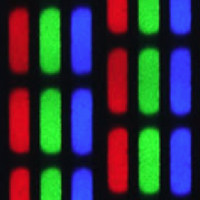How Does a Color Television Make Colors?
The processes of color television that allow pictures of some scene to be captured and then transmitted to our homes for viewing (sometimes live while the captured events, such as s sporting event, are happening) are very complex. Focussing on the color aspect, color television relies on the number three that is so important in color. Since our visual systems can only respond three types of color using our three types of cone receptors, color television can recreate beautiful full-color pictures from just three black and white images. This is done by capturing three images that represent the red light, green light, and blue light in the original scene. After transmission to our home TV (or computer screen), that information is put back together by emitting roughly equivalent amounts of red, green, and blue light on the display. Since our eyes can only judge the relative amounts of the three types of light, we see a full color picture.
The process for making color described above is known as additive color mixing. Additive mixing happens when colored light is superimposed to make new colors. This can happen by projecting different color lights on top of one another, by flashing the lights so quickly we can't see the individual colors, or by making adjacent patches of the colors so small that they blur together in our eyes. It is this last technique (small dots of light) that is most often used in color television. However, some systems do use the other techniques.
There are other important parts of making color television work. These include breaking the picture up into small spots of light, called pixels, and mathematically encoding that information so that it can be processed in computers. The data is then compressed to make it easier to transmit to us through satellites, cable systems, or over-the-air radio transmission. Then the picture and sound information is transmitted and received and decoded by the tuners and processors in our TV (or set-top box). Finally the pictures are displayed for us to view.
![]()
Explore the NEXT TOPIC at this level.
Explore the NEXT LEVEL on this topic.
Ever wonder ... Can my computer really display "millions" of colors??
Updated: Apr. 19, 2011

